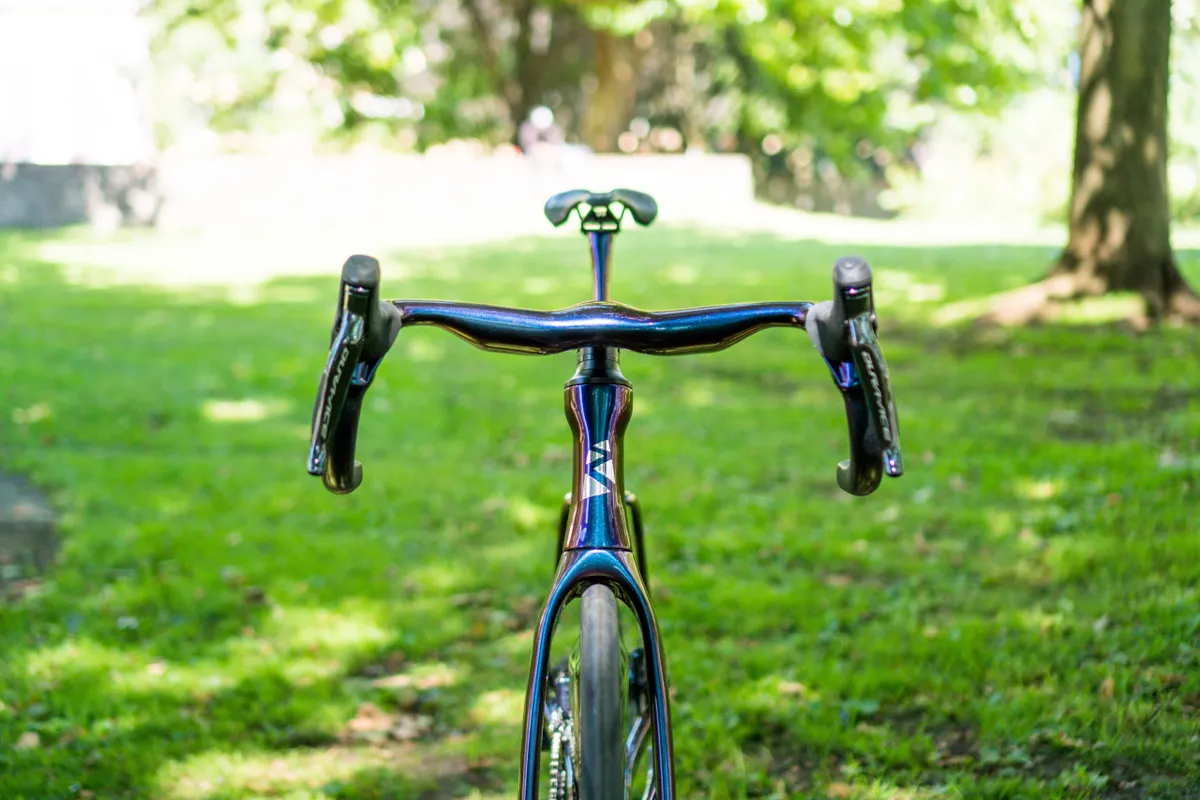The UCI’s new rules limiting handlebar width to a minimum of 400mm in road and cyclocross events have sparked a backlash.
Speaking to BikeRadar, a source close to the consultation, who has worked with WorldTour teams, warned the changes will compromise rider fit, ergonomics and competitiveness, particularly for smaller riders.
The source added that the rules, which come into force in 2026, will pose major challenges for bike brands and component manufacturers. “Six months [to implement changes] is wild from a development perspective – it’s impossible, really,” they said.
While the rules won’t take effect until 2026, manufacturers and fitters will already be working to adapt – yet the short lead time leaves little room for prototyping, testing or rider feedback.
According to the UCI, the new regulations are based on safety recommendations from SafeR, the rider-safety body established by the sport’s key stakeholders.
However, our source claims their input was dismissed during consultations, despite repeated attempts to raise concerns over fit, performance and inclusivity.
The handlebar-width rules form part of a sweeping overhaul of the UCI’s equipment regulations. The changes also see the introducion of a minimum 320mm measurement from hood to hood, with mass-start track events adopting a slightly narrower 350mm minimum from 2027.
The regulation is widely seen as a response to the growing trend of ultra-narrow bars and sharply inward-angled brake hoods, increasingly favoured by pro riders in pursuit of aerodynamic gains.
5 key things you need to know about the UCI’s new handlebar rules
- Minimum width set for road and CX: From 1 January 2026, handlebars on road and cyclocross bikes must be at least 400mm wide (measured outside-to-outside), with a minimum hood-to-hood width of 320mm
- Track racing follows in 2027: Track mass-start events will see a slightly narrower minimum of 350mm from 1 January 2027
- Ban on ultra-narrow setups: The rules effectively outlaw the use of bars narrower than 400mm at the drops – shutting down the widespread trend for 32 to 38cm setups among pros
- Flared bars face limits: Riders may struggle to use flared bars that bring the hoods closer together for an aero advantage without violating the new 320mm hood-to-hood rule
- Concerns over rider fit: Critics argue the rules unfairly impact smaller riders, particularly women, and could force changes to long-established and ergonomic race setups
The rise of ultra-narrow bars

Super-narrow bars are nothing new – as far back as 2018, riders such as Jan-Willem van Schip were running skinny bars designed for track racing.
But Riders such as Taco van der Hoorn have been at the forefront of the accelerating trend towards mainstream adoption of narrower bars, with the Dutchman frequently seen racing on bars as narrow as 32cm, paired with aggressively tilted-in shifters.
Brands have been quick to respond, with bars such as the Profile Design Canta – which is available in widths as narrow as 36cm – reflecting a shift towards narrow options.
But why go narrow in the first place?
A rider’s body contributes around 80 per cent of the total aerodynamic drag. A skinnier handlebar forces you into a significantly narrower position – low-hanging aero fruit.

But this aero gold rush has raised concerns, too. Some observers argue that handling and safety are being sacrificed, particularly in bunch sprints or crosswinds.
While the UCI has been quick to ban extreme bars such as the Speeco Aero Breakaway, the new regulations appear to be a preemptive strike against setups that nibble away at the edges of compliance, and an attempt to establish clear boundaries around what’s acceptable in competition.
Although safety is cited as a motivator, the UCI also says the new limits are intended to simplify enforcement and reduce the growing disparity in equipment styles.
Flared designs and fit dilemmas

Outside of aero gains, narrow handlebars can offer a better fit for smaller riders.
Traditionally, fitting guides recommended matching bar width to the rider’s acromion-to-acromion shoulder width (the bony protrusions at the outer edge of your shoulders).
This, it is claimed, places the arms in a neutral position, aligning with the shoulder joints to reduce strain. This (and tradition) led to 40-to-44cm wide handlebars becoming the norm.
However, selecting handlebar width based strictly on shoulder width is more of a bike-fit myth than a scientifically proven principle.
Many riders, particularly shorter women, benefit from using bars narrower than 40cm – but the new rules will leave them with fewer viable options, potentially forcing them onto wider, less ergonomic setups that compromise comfort, control and long-established race positions.

“The new rules are hugely discriminatory against women and smaller men,” explained our source, adding that “it will shift the demographic of winning riders to taller riders."
In one closed-door meeting, Cervélo reportedly warned that 14 of the 18 women on its Visma–Lease a Bike team would be forced to change their handlebars to remain compliant – highlighting the real-world impact on elite athletes already riding optimised fits.
A further complication arises from the interaction between the new width rules and bar shape.
Flared bars that measure 400mm at the drops, but bring the hoods close together – sometimes as narrow as 300mm – are increasingly popular.
But the new rules limit these designs. To meet the 400/320 requirement, a bar would need only a 2-degree flare, which some fitters say is insufficient for ergonomics and could lead to wrist pain or awkward positioning.
“You can’t make an ergonomic bar with 400mm drops and 320mm hoods,” said the same source. “It just doesn’t work without compromising comfort.”
Still, the UCI’s move marks a line in the sand. The era of ever-narrower bars may be drawing to a close, as cycling’s governing body reasserts control over cockpit design in the name of safety and standardisation.



